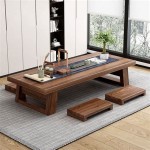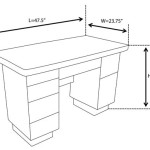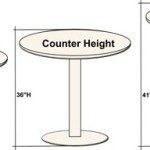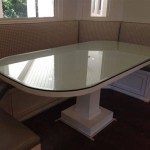White Marble Table Top Covers: Protection and Aesthetics
White marble table top covers represent a functional and decorative solution for preserving and enhancing the beauty of tables. These covers, crafted from various materials and designed to mimic the elegant appearance of white marble, offer a protective barrier against spills, scratches, and other forms of damage. The selection of a suitable white marble table top cover involves careful consideration of several factors, including the material composition, size, shape, thickness, and overall design, to ensure optimal protection and a seamless integration with the existing décor.
The inherent vulnerability of natural marble contributes significantly to the demand for protective covers. Marble, while aesthetically pleasing, is a porous material susceptible to staining from liquids such as wine, coffee, and oil. Acids, even those found in common household cleaners or citrus fruits, can etch the surface, leaving permanent marks. Physical damage, such as scratches and chips, can also detract from the material's luster and value. White marble table top covers thus serve as a crucial preventative measure, shielding the underlying surface from these potential hazards.
Beyond protection, these covers serve as aesthetic enhancements. The clean, bright look of white marble complements a wide range of interior design styles, from classic to contemporary. A well-chosen cover can elevate the overall ambiance of a room, adding a touch of sophistication and elegance. The availability of different patterns and finishes further allows for personalization and customization, enabling individuals to create a unique and cohesive visual experience.
The durability and longevity of a white marble table top cover depend heavily on the material from which it is constructed. Several materials are commonly employed, each possessing distinct advantages and disadvantages. Understanding these characteristics is essential for making an informed purchasing decision.
One popular option is PVC (polyvinyl chloride). PVC covers are known for their affordability, water resistance, and ease of cleaning. They are readily available in various thicknesses and textures, allowing for some degree of customization. However, PVC is not particularly heat resistant and may melt or warp under high temperatures. It is also less aesthetically appealing than some other options, and its synthetic appearance may not fully replicate the look of natural marble. Furthermore, concerns exist regarding the environmental impact of PVC production and disposal.
Acrylic is another material used for white marble table top covers. Acrylic offers greater clarity and a more realistic marble-like appearance compared to PVC. It is also more durable and resistant to scratches. However, acrylic tends to be more expensive than PVC. While it handles heat better than PVC, prolonged exposure to high temperatures can still cause warping or discoloration. Cleaning acrylic requires specific cleaning agents to avoid scratching the surface.
Tempered glass provides a robust and elegant option for table top protection. Tempered glass is significantly stronger than regular glass and is designed to shatter into small, relatively harmless pieces upon impact, reducing the risk of injury. Its smooth, non-porous surface is easy to clean and resistant to stains. However, tempered glass can be more expensive than PVC or acrylic. While it is heat resistant, sudden temperature changes can cause it to crack. Furthermore, the transparent nature of glass may not fully replicate the opaque look of white marble, although frosted or textured options can mitigate this to some extent. Glass covers sometimes require the use of silicone bumpers to prevent sliding.
Laminate materials, consisting of a thin layer of decorative paper or plastic bonded to a core material such as particleboard or MDF, are also used for creating white marble table top covers. Laminate provides a relatively inexpensive and durable option. It is available in a wide variety of patterns and finishes designed to mimic the look of marble. However, laminate is susceptible to chipping or peeling, particularly along the edges. It is also less heat resistant than tempered glass or solid surface materials. Water damage can cause the core material to swell, compromising the integrity of the cover.
Solid surface materials, such as Corian and similar acrylic-based composites, offer a high-end option for white marble table top covers. These materials are non-porous, stain-resistant, and heat resistant. They can be seamlessly joined to create larger surfaces without visible seams. Solid surface materials are also highly durable and can be repaired if damaged. However, they are considerably more expensive than other options. While they resemble natural stone, they lack the unique veining and variations found in genuine marble.
Material Selection Considerations
The selection of an appropriate material for a white marble table top cover must consider the intended use of the table. Tables used for dining, for example, require covers that are highly resistant to stains and easy to clean. Temperate glass or solid surface materials are well-suited for this purpose. Tables used primarily for decorative purposes may benefit from the aesthetic appeal of acrylic or laminated covers.
Budget is another crucial factor. PVC covers offer the most affordable option, while solid surface materials represent the most expensive. Acrylic and tempered glass fall in the middle range. The initial cost must be weighed against the material's durability and longevity to determine the most cost-effective solution in the long run.
The desired aesthetic is also paramount. If a realistic marble-like appearance is essential, acrylic or solid surface materials are preferable. If protection and affordability are the primary concerns, PVC or laminated covers may suffice. Tempered glass offers a clean and modern look that complements various design styles.
Maintenance and Cleaning
Proper maintenance and cleaning are essential for preserving the appearance and extending the lifespan of a white marble table top cover. The specific cleaning methods will vary depending on the material.
PVC covers can typically be cleaned with a damp cloth and mild detergent. Abrasive cleaners should be avoided, as they can scratch the surface. For stubborn stains, a solution of baking soda and water can be applied gently. Regular cleaning is essential to prevent the buildup of dirt and grime.
Acrylic covers require gentle cleaning with a microfiber cloth and a dedicated acrylic cleaner. Harsh chemicals and abrasive cleaners should be avoided, as they can damage the surface. Scratches can sometimes be removed with a specialized acrylic polishing compound but should ideally be performed by professional.
Tempered glass covers can be cleaned with a glass cleaner and a soft cloth. Stubborn stains can be removed with a razor blade, but care must be taken to avoid scratching the surface. Silicone bumpers should be cleaned periodically to prevent the buildup of dirt and grime.
Laminate covers can be cleaned with a damp cloth and mild detergent. Abrasive cleaners and scouring pads should be avoided, as they can damage the surface. Spills should be wiped up immediately to prevent water damage.
Solid surface covers can be cleaned with a damp cloth and mild detergent. Abrasive cleaners should be avoided, as they can dull the surface. Scratches can usually be removed with a fine-grit sandpaper or a specialized solid surface cleaner. Regular cleaning is essential to maintain the material's luster.
Installation and Customization
The installation of a white marble table top cover is generally straightforward. Covers are typically placed directly on the table surface. For larger or heavier covers, two people may be required for safe installation. Silicone bumpers or other adhesive pads can be used to prevent the cover from sliding.
Customization options are available to tailor the cover to specific table sizes and shapes. Many manufacturers offer custom cutting services, allowing customers to order covers that perfectly fit their tables. Edge treatments, such as beveled or rounded edges, can also be customized to enhance the aesthetic appeal and safety of the cover. Patterns and finishes can be selected to match the existing décor.
The thickness of the cover can also be customized. Thicker covers provide greater protection against impact and damage. Thinner covers offer a more subtle and less obtrusive look. The optimal thickness will depend on the intended use of the table and the desired level of protection.

White Marble Dining Table Top At Best In New Delhi By Wasim Id 20711066588

Brielle Home Fitted Indoor Outdoor White Marble Table Cover For 48 In Round The Covers Department At Com

Buy Selenite Stone Table Top Marble White Inlay Dining Countertop Slab Coffee Handmade Furniture In

5 Marble Table Top Designs For Your Dining Room

15 Table Tops Ideas In Porcelain Tile Atlas Plan

Marble Table Tops Restaurant Top

Perfect Tables 24 Outdoor Round Florence Marble Table Top

Design Recipes Dine On Discover The Best Trending Dinning Room Table Decor Marble Top Dining White Leather Chairs

Buy Leighton Marble Top Dining Table Tables Fancy Homes

Ostepdecor 2 0mm Thick Clear 60 Inches Round Table Cover Protector Pad Heavy Duty Top For Di Dining Room








